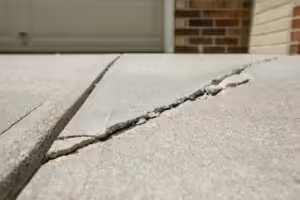When you bought your house, a big draw was the patio in the backyard. You envisioned large family gatherings, entertaining friends and colleagues, and your personal favorite, quiet moments alone outdoor with your significant other. Time outdoors is not only enjoyable, but studies show there are emotional and health benefits from positive time spent relaxing outdoors. You did not anticipate a Concrete Patio Restoration project.
Why Patios Need Concrete Patio Restoration
However, time has not been kind to the patio. While concrete is durable, it does require maintenance and repairs from time to time; perhaps you are seeing cracks, uneven surfaces, or discoloration. Your prime outdoor living space is now looking a little rugged.
The good news: most concrete problems can be repaired if caught early. Instead of “just dealing” with concrete problems, here are some simple and cost-effective ways to revitalize cracked, sunken, and dirty patios.
Sunken or Uneven Concrete Slabs
A common issue with large patio slabs is settling, which creates an uneven concrete surface. Often, patios are added as an afterthought, and the yard may not have been prepared for proper stormwater drainage. Downspouts discharge stormwater directly onto the patio, washing away the fill beneath the slab.
Common causes of sunken patios:
- Poor stormwater drainage
- Improper grading
- Eroded or washed-out soil
- Compacted or settling fill beneath slab
Not only is this unsightly, but it creates a tripping hazard and may direct water toward your foundation instead of away from it. Addressing drainage problems early helps prevent major foundation damage. If left unsupported, the existing slab can develop large cracks, eventually requiring complete replacement.

A Modern Fix for Uneven Patios
If this seems like a big problem, take heart – it’s easier to solve than you might think. Modern materials and advanced application methods can fix it quickly and for a fraction of the cost of a new concrete porch or patio.
How it Works:
Small holes are drilled through the existing concrete surface, and high-density polyurethane foam is injected underneath. This foam expands to fix cracks, fill voids, and lift the slab back to its original position. The injection holes are patched, and the patio surface is restored for a seamless look. Plus, the foam won’t shrink or erode over time, making it a lasting solution. The installation process takes just a few hours, with remarkable results.
Stained or Dirty Surfaces
Concrete resurfacing isn’t always necessary for a stained or dirty patio. Existing concrete is porous and picks up dirt and stains from the environment. Organic stains from natural stone, leaves, pollen, or tree sap can make your concrete porch look worn. Many homeowners think they need a complete concrete coating or decorative concrete treatment, but simple cleaning can often do the trick.
How to Clean a Dirty Patio
If your patio looks dark or mottled, start by power washing it. Water under pressure (at least 3000 psi) removes most stains, and cleaning chemicals can be added for stubborn spots. Using an orbital attachment provides the best results. In many cases, a thorough cleaning is enough to refresh your patio surface, restoring its curb appeal without expensive replacements.
Cracks and Joints
As concrete cures, it shrinks, causing cracks. When your existing concrete surface was poured, control joints were cut to minimize visible cracking. Over time, water seeps into these joints and cracks, causing further damage. Heavy rainfall can wash out the fill under your slab, leading to concrete sinking. In freezing climates, water expands in the cracks, worsening the issue.

How to Seal and Protect Cracks
Small cracks are normal and often harmless, but larger ones should be addressed. Using a high-quality silicone caulk helps fix cracks and prevent water intrusion. Silicone remains flexible, resists UV damage, and won’t shrink or crack. For a seamless look, choose a color that matches your stamped concrete, concrete overlay, or traditional patio finish. Keeping cracks sealed will help maintain the good shape of your patio long-term.
Patio Resurfacing Options
If your patio surface is still structurally sound but looks worn, consider patio resurfacing instead of full replacement. Resurfacing is a budget-friendly way to update your patio without the expense of tearing out and repouring concrete. A stamped concrete overlay or concrete coating can refresh an old slab, making it look like brand new stone, tile, or brick at a fraction of the cost of using different materials.
A professional contractor can apply a resurfacing material over your concrete to improve both function and aesthetics. Whether you want a smooth surface, a stamped concrete look, or a decorative pattern, resurfacing is a great way to extend the life of your patio while boosting curb appeal.
Proactive Care for Your Patio
Water is the biggest enemy of existing concrete. You might assume something as solid as concrete would shed water, but it’s actually porous. Water seeps in, leaching away bonding agents and leading to deterioration. Freezing, thawing, and using rock salt in winter can also cause damage.
Sealants That Protect Your Patio
Common signs of water damage include flaking, scaling, and pop-outs on the concrete surface. To protect your investment, apply a high-quality concrete coating or penetrating sealer.
Expert Tip: We recommend a long-lasting sealant rather than an acrylic option. Penetrating sealers last 5-10 years compared to just two years for acrylics, and they won’t alter the color or texture of your patio. Proper sealing prevents moisture damage and keeps your patio surface in good shape for years to come.
Let Us Help with Your Concrete Patio Restoration
When you are ready to fix that uneven concrete, call us at 832-995-2000 to schedule your free inspection for concrete patio repair. Leveled Concrete offers concrete resurfacing, leveling, power washing, caulking, and sealant services.
Our local pros will assess your patio and recommend the best solution to repair and restore your existing concrete surface. Whether it’s foam concrete lifting, sealing, or resurfacing, we’ve got you covered!
Leveled can schedule a free inspection to help with your concrete porch or patio restoration project.

